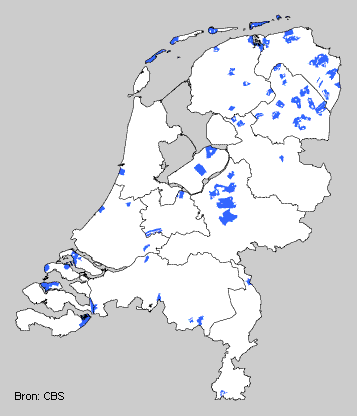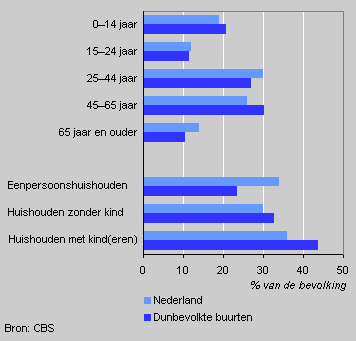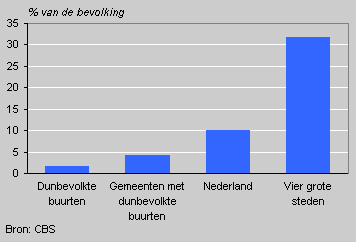Residents of sparsely populated areas

In 2004 there were 84 sparsely populated districts in the Netherlands scattered over 58 municipalities. Two-thirds of these sparsely populated municipal districts are found in the northern and eastern part of the Netherlands. The remainder were situated in the provinces of Zeeland, South Holland and North Brabant. There is only one sparsely populated municipal district in the province of North Holland. The provinces of Utrecht and Limburg have very few sparsely populated districts.
Sparsely populated areas in the Netherlands, 1 January 2004

More children
The number of large families in thinly populated districts (21 percent) exceeds the nationwide average (19 percent).
Residents aged between 45 and 65 are also more numerous in thinly populated districts where they make up 30 percent of the population, whereas the national average is 26 percent. The other age categories are underrepresented.
Composition in sparsely populated areas, 1 January 2004

Relatively few singles
The age distribution in sparsely populated districts seems to indicate that large families are overrepresented. In fact, 45 percent of households in these areas have children as against 36 percent nationwide. With 24 percent the proportion of one-person households is substantially below the national average of 34 percent.
More men in sparsely populated districts
More men (53 percent) than women (47 percent) live in sparsely populated municipal districts. In the Netherlands as a whole, women constitute the majority because they tend to outlive men. The number of persons over the age of 65 is relatively low in thinly populated areas, thus cancelling out the effect of the women surplus in the higher age categories.
Proportion of non-western foreigners, 1 January 2004

Low proportion of non-western foreigners
On average, 10 percent of the population in the Netherlands belong to the category of non-western foreigners and are mainly found in cities. The proportion in thinly populated municipal districts is only 2 percent.
Thinly populated areas where reception centres for asylum seekers are located, are standing out. In the district of Deelen, situated in the municipality of Ede for example, non-western foreigners make up no less than 51 percent of the local population. The average proportion of non-western foreigners in the 83 thinly populated municipal districts (excluding Deelen) is indeed only 1 percent. In the 58 municipalities where sparsely populated areas are found, the percentage of non-western foreigners is on average slightly higher with 4 percent.
Chantal Melser